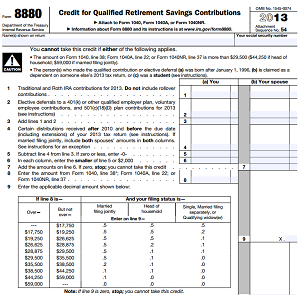 The tax code is full of ways to lower to your taxes. The Saver’s Credit (formerly the Retirement Savings Contribution Credit) is a tax credit for something we should be doing anyways, saving for retirement. This is on top of the great tax benefits already offered by retirement plans. With a little tax planning you can turn this tax credit into big savings.
The tax code is full of ways to lower to your taxes. The Saver’s Credit (formerly the Retirement Savings Contribution Credit) is a tax credit for something we should be doing anyways, saving for retirement. This is on top of the great tax benefits already offered by retirement plans. With a little tax planning you can turn this tax credit into big savings.
What Is It?
The Saver’s Credit helps those taxpayers who save for retirement but are on the lower end of the income scale. Consider it a reward for being a responsible saver, in that it helps offset part of your contributions each year.
Here’s how it works. The Saver’s Credit offsets 50%, 20%, or 10% of the first $2,000 ($4,000 if married filing jointly) of your retirement contributions each year. That gives you up to a maximum tax credit of $1,000 ($2,000 if married filing jointly) each year.
The amount of the credit depends on your adjusted gross income, filing status, and the amount you contribute to a retirement plan each year. The credit is non-refundable, meaning it won’t add to a refund. It can only lower your tax bill to zero.
Saver’s Credit Eligibility
The tax code doesn’t allow everyone this opportunity. You still need to qualify first. You must be:
- Age 18 or older
- Not a full-time student
- Not claimed as a dependent
- Meet the income requirements below
Your retirement savings for the year must be made to an eligible retirement plan. All contributions to a traditional or Roth IRA, 401k, 403b, 457, Simple IRA, or SARSEP will count toward the saver’s credit.
If you don’t have a retirement plan through work or prefer to use an IRA, you have until the IRA deadline to make any last-minute contributions for last tax year. You can start a new IRA or use an existing account, just make sure to check the correct tax year when making the deposit.
2016 Saver’s Tax Credit Table
| Tax Credit | Single or Married Filing Separately | Married Filing Jointly | Head of Household |
| 50% of contribution | up to $18,500 | up to $37,000 | up to $27,375 |
| 20% of contribution | $18,501 – $20,000 | $37,001 – $40,000 | $27,376 – $29,625 |
| 10% of contribution | $20,001 – $30,750 | $40,001 – 61,500 | $29,626 – $45,750 |
2015 Saver’s Tax Credit Table
| Tax Credit | Single or Married Filing Separately | Married Filing Jointly | Head of Household |
| 50% of contribution | up to $18,250 | up to $36,500 | up to $27,375 |
| 20% of contribution | $18,251 – $19,750 | $36,501 – $39,500 | $27,376 – $29,625 |
| 10% of contribution | $19,751 – $30,500 | $39,501 – 61,000 | $29,626 – $45,750 |
2014 Saver’s Tax Credit Table
| Tax Credit | Single or Married Filing Separately | Married Filing Jointly | Head of Household |
| 50% of contribution | up to $18,000 | up to $36,000 | up to $27,000 |
| 20% of contribution | $18,001 – $19,500 | $36,001 – $39,000 | $27,001 – 29,250 |
| 10% of contribution | $19,501 – 30,000 | $39,001 – $60,000 | $29,251 – $45,000 |
How To Claim It
To claim the Saver’s Credit, you need to fill out Form 8880 then attach it to your 1040 or 1040A when you file your tax return. The directions walk you through the process. Or, any recommended tax software, like TurboTax, will do the work for you.
